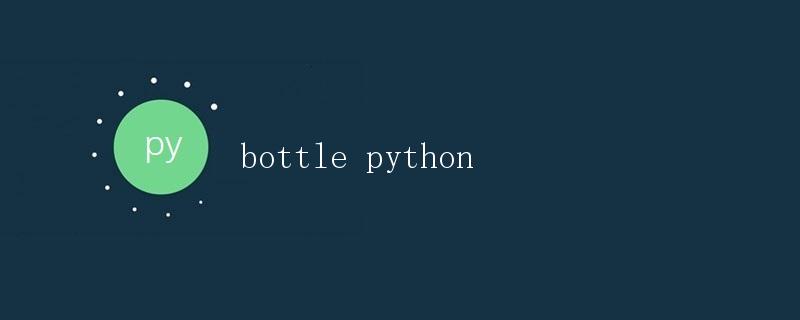Python Bottle框架

Bottle是一个轻量级的Python Web框架,它非常适合用于快速开发小型Web应用程序。Bottle具有简单易用的API和内置的开发服务器,使得开发过程变得非常简单和高效。在本文中,我们将详细介绍Bottle框架的各种功能和用法,帮助您快速上手并开始使用Bottle来构建Web应用。
安装Bottle
首先,我们需要安装Bottle框架。您可以使用pip来安装Bottle,只需运行以下命令:
pip install bottle
安装完成后,您就可以开始使用Bottle框架来构建Web应用了。
Hello World
让我们从一个简单的”Hello World”应用程序开始。以下是一个简单的Bottle应用程序,它只是返回一个”Hello World”的字符串:
from bottle import route, run
@route('/')
def hello():
return "Hello World"
run(host='localhost', port=8080)
在上面的代码中,我们定义了一个路由'/',当访问根路径时,会调用hello()函数并返回”Hello World”字符串。然后我们使用run()函数来运行应用程序,指定主机和端口。
运行上面的代码,然后在浏览器中访问http://localhost:8080,您将看到页面上显示”Hello World”。
路由
Bottle使用装饰器来定义路由。您可以使用@route()装饰器来指定URL路径和HTTP方法。以下是一个简单的示例:
from bottle import route, run
@route('/hello')
def hello():
return "Hello"
@route('/bye')
def bye():
return "Bye"
run(host='localhost', port=8080)
在上面的代码中,我们定义了两个路由'/hello'和'/bye',分别对应hello()和bye()函数。当访问/hello路径时,会返回”Hello”字符串;当访问/bye路径时,会返回”Bye”字符串。
请求参数
Bottle允许您从URL中获取请求参数。您可以在路由路径中使用占位符来捕获参数。以下是一个示例:
from bottle import route, run
@route('/hello/<name>')
def hello(name):
return f"Hello {name}"
run(host='localhost', port=8080)
在上面的代码中,我们定义了一个路由'/hello/<name>',其中<name>是一个占位符,用于捕获URL中的参数。当访问/hello/geek-docs路径时,会返回”Hello geek-docs”字符串。
静态文件
Bottle还支持提供静态文件,例如CSS、JavaScript和图像文件。您可以使用static_file()函数来提供静态文件。以下是一个示例:
from bottle import route, run, static_file
@route('/static/<filename>')
def server_static(filename):
return static_file(filename, root='./static')
run(host='localhost', port=8080)
在上面的代码中,我们定义了一个路由'/static/<filename>',其中<filename>是静态文件的名称。然后我们使用static_file()函数来提供静态文件,指定静态文件的根目录为'./static'。
模板引擎
Bottle支持使用模板引擎来生成动态内容。您可以使用template()函数来渲染模板文件。以下是一个使用模板引擎的示例:
from bottle import route, run, template
@route('/hello/<name>')
def hello(name):
return template('hello_template', name=name)
run(host='localhost', port=8080)
在上面的代码中,我们定义了一个路由'/hello/<name>',然后使用template()函数来渲染名为hello_template的模板文件。模板文件内容如下:
<!DOCTYPE html>
<html>
<head>
<title>Hello {{name}}</title>
</head>
<body>
<h1>Hello {{name}}</h1>
</body>
</html>
当访问/hello/geek-docs路径时,会渲染模板文件并显示”Hello geek-docs”。
请求对象
Bottle提供了request对象来访问HTTP请求的信息,例如请求方法、请求头和请求参数。以下是一个示例:
from bottle import route, run, request
@route('/hello')
def hello():
method = request.method
headers = request.headers
params = request.query
return f"Method: {method}, Headers: {headers}, Params: {params}"
run(host='localhost', port=8080)
在上面的代码中,我们定义了一个路由'/hello',然后通过request对象获取请求的方法、头部和参数信息,并返回给客户端。
响应对象
Bottle提供了response对象来设置HTTP响应的信息,例如响应状态码、响应头和响应内容。以下是一个示例:
from bottle import route, run, response
@route('/hello')
def hello():
response.status = 200
response.set_header('Content-Type', 'text/plain')
response.body = "Hello"
return response
run(host='localhost', port=8080)
在上面的代码中,我们定义了一个路由'/hello',然后使用response对象设置响应的状态码、头部和内容,并返回给客户端。
中间件
Bottle允许您使用中间件来处理请求和响应。您可以使用install()函数来安装中间件。以下是一个示例:
from bottle import route, run, install, response
def custom_middleware(callback):
def wrapper(*args, **kwargs):
response.set_header('X-Custom-Header', 'Custom Value')
return callback(*args, **kwargs)
return wrapper
install(custom_middleware)
@route('/hello')
def hello():
return "Hello"
run(host='localhost', port=8080)
在上面的代码中,我们定义了一个自定义中间件custom_middleware,它会在每次请求时设置一个自定义头部。然后我们使用install()函数安装中间件,使其生效。
错误处理
Bottle允许您定义错误处理程序来处理各种HTTP错误。您可以使用@error()装饰器来定义错误处理程序。以下是一个示例:
from bottle import route, run, error
@route('/hello')
def hello():
return 1 / 0
@error(500)
def error500(error):
return "Internal Server Error"
run(host='localhost', port=8080)
在上面的代码中,我们定义了一个路由'/hello',然后在路由处理函数中引发一个除零错误。然后我们使用@error(500)装饰器来定义处理500错误的错误处理程序。
插件
Bottle允许您使用插件来扩展框架的功能。您可以使用install()函数来安装插件。以下是一个示例:
from bottle import route, run, install, Plugin
class CustomPlugin(Plugin):
name = 'custom_plugin'
def apply(self, callback, route):
def wrapper(*args, **kwargs):
result = callback(*args, **kwargs)
return f"Custom Plugin Result: {result}"
return wrapper
install(CustomPlugin())
@route('/hello')
def hello():
return "Hello"
run(host='localhost', port=8080)
在上面的代码中,我们定义了一个自定义插件CustomPlugin,它会在每次请求时对处理函数的结果进行处理。然后我们使用install()函数安装插件,使其生效。
请求钩子
Bottle允许您使用请求钩子来在请求处理前或处理后执行一些操作。您可以使用@hook()装饰器来定义请求钩子。以下是一个示例:
from bottle import route, run, hook
@hook('before_request')
def before_request():
print("Before Request")
@hook('after_request')
def after_request():
print("After Request")
@route('/hello')
def hello():
return "Hello"
run(host='localhost', port=8080)
在上面的代码中,我们使用@hook('before_request')装饰器定义了一个在请求处理前执行的钩子函数before_request,以及一个在请求处理后执行的钩子函数after_request。当访问/hello路径时,会触发这两个钩子函数。
完整示例
下面是一个完整的Bottle应用程序示例,包括路由、模板引擎、静态文件、中间件和错误处理:
from bottle import route, run, template, static_file, install, response, error
@route('/')
def index():
return template('index_template')
@route('/static/<filename>')
def server_static(filename):
return static_file(filename, root='./static')
def custom_middleware(callback):
def wrapper(*args, **kwargs):
response.set_header('X-Custom-Header', 'Custom Value')
return callback(*args, **kwargs)
return wrapper
install(custom_middleware)
@error(500)
def error500(error):
return "Internal Server Error"
run(host='localhost', port=8080)
在上面的代码中,我们定义了一个路由'/',用于显示一个模板页面;定义了一个路由'/static/<filename>',用于提供静态文件;安装了一个自定义中间件;定义了处理500错误的错误处理程序。
通过以上示例,您可以了解到Bottle框架的基本用法和各种功能。
 极客教程
极客教程